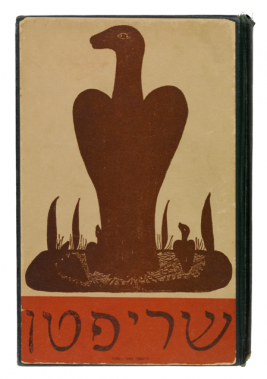The Modernists

Between 1907 and 1939, Yiddish modernism gave rise to constellations of avant-garde poets and writers in many cosmopolitan centers, including Berlin, Warsaw, Lodz, Kiev, Vilna, and New York.
In New York, Di Yunge (The Young Ones) promoted “art for art’s sake,” hoping to lead American Yiddish poetry beyond the so-called Sweatshop Poets, whom they denigrated as “the rhyme department of the Jewish labor movement.” Figures such as Mani Leib, Reuven Eisland, and Zishe Landau established New York as a major address for Yiddish poetic innovation. Shriftn, one of several journals, featured the latest Yiddish poetry as well as sophisticated criticism, graphic art, and translations of American and world literature, from Walt Whitman to the Bengali poet Rabindranath Tagore.
The Inzikhistn (Introspectivists) arose in 1919 as a group of lyric poets who emphasized subjectivity, wordplay, and free verse. The founding members were Aaron Glanz-Leyeles, N. B. Minkoff, and Jacob Glatstein.
Another group of literary rebels emerged in response to the bloody upheavals of the Great War and the Bolshevik Revolution. Inspired by German Expressionism and Russian Futurism, Melech Ravitch, Uri Zvi Greenberg, and Peretz Markish were dubbed Di Khalyastre (The Gang), a name they embraced with pride. They brought the experience of violent disruption to their work: “We measure the quality of our poetry not according to beauty but rather by horror.”
In contrast to the efforts of Di Yunge, the Inzikhistn, and Di Khalyastre to overthrow prevailing literary trends, the young writers of Vilna sought to reconcile the city’s commitment to literary tradition with the political challenges of the 1930s. Avrom Sutzkever, Chaim Grade, and Leyzer Volf emerged as the leading voices of Yung Vilne (Young Vilna), the last of the interwar literary groups.
More on the Yiddish modernists from our collections
Di Yunge—A Group of American-Jewish Literary Rebels, a recording, in English, from our Francis Brandt Online Yiddish Audio Library, of a talk given by Yiddish scholar Ruth Wisse.
Many view Avrom Sutzkever as the quintessential Yiddish modernist poet; he was also viewed as a spokesperson for Yiddish literature in the post-Holocaust era and as a near-mythic national hero. In these recordings from the Jewish Public Library in Montreal—transcribed and translated into English—a more intimate image of Sutzkever emerges.
Chapter 13 of the novel Hibru by Joseph Opatoshu (1886–1954), one of the leading modernist writers affiliated with Di Yunge, translated by Shulamith Berger. The novel portrays the professional and personal lives of young immigrant men who worked as Hebrew school teachers on the Lower East Side of New York City.
Avrom Sutzkever reads “The Ballad of Young Vilna,” in 1964, from our collection of recordings of events at Montreal’s Jewish Public Library.
Dvoyre Fogel was a modernist Yiddish writer, philosopher, art critic, and translator, who, according to translator Anastasiya Lyubas, inhabited interstitial spaces not only between Polish modernism and the Yiddish modernist renaissance movement in Eastern Europe and North America but also between genres of artistic expression. You can read her prose montage, Acacias Bloom, as well as her poems "Circular Landscapes" and "Sunday of Suburban Houses."
